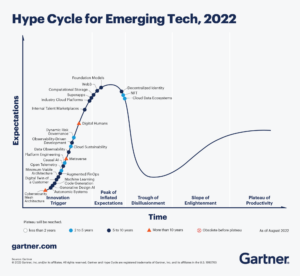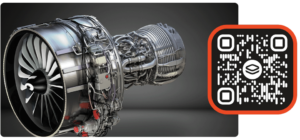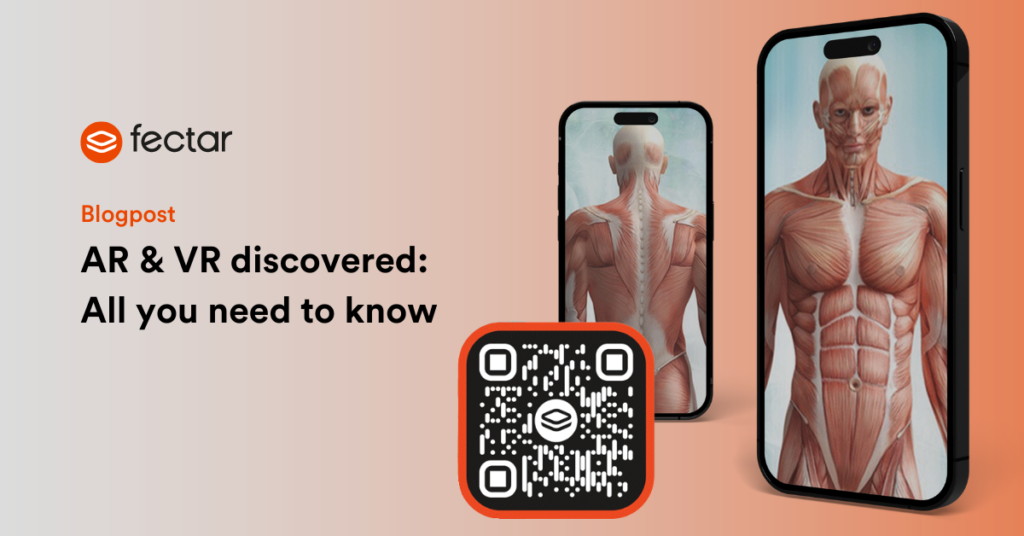Love it or hate it, technology is an integral characteristic of our species, and it has made us what we are. Since the first human beings started using stone tools to obtain and prepare food, we’ve been on a continuous path towards developing newer and better technology.
This process has led to a preponderance of different tools – and they all have one thing in common: each is designed to overcome a fundamental limitation and extend our natural abilities. The most exciting of these is the advent of immersive visual technologies, Augmented Reality and Virtual Reality. Both tools extend our natural capability to imagine and share ideas – and in more detail than ever before.
As these technologies become more widespread, a lot of people want to know what augmented reality (AR) and virtual reality are, and how they compare to each other.
It’s easy to understand the confusion: both technologies use a shared vocabulary, and seem to have a connection to ‘the metaverse’ – whatever that is (we’ll get to that in a moment). However, getting to grips with this technological frontier is essential.
We’re at the same stage today with VR and AR as the internet was in the early 2000s. Businesses that fail to adopt these technologies today will be left so far behind that they will lose relevance altogether.
We’ll look at how you can start using these technologies in a moment. But first, let’s look at AR and VR, and see what sets them apart.
Augmented Reality (AR) vs Virtual Reality (VR) – what are they?
The difference between augmented reality (AR) and virtual reality (VR) can be reduced to one simple fact: while AR adds to our real-world visual field, VR blocks it out and replaces it with an entirely new one.
Both AR and VR are immersive experiences that enhance our natural imaginative capabilities by allowing people to create and share ideas with 3D content. This 3D content is displayed via dedicated devices such as goggles (for VR and AR) or smartphones and tablets (AR).
It’s worth noting, there’s a big difference between VR goggles (such as Meta Quest or Pico) and AR glasses (such as HoloLens). While VR goggles exclude light from the real world, AR glasses allow you to see everything around you – just like a regular pair of eyeglasses or sunglasses would. The key feature with AR glasses is that they superimpose virtual 3D elements onto the real world, thereby augmenting it.
What is the metaverse?
There’s a lot of confusion about the metaverse – made worse by companies that have tried to claim ownership and steer the development of this concept.
In reality, the metaverse doesn’t belong to any one person or company – it’s simply the term given to the ability to share and connect virtual immersive experiences such as VR and AR.
In this respect, it’s useful to think of the metaverse as being an internet for virtual 3D experiences. It’s a virtual universe that is ready for molding into whatever you want it to be.
It’s worth being aware of Amara’s Law when it comes to new technologies, including the metaverse, VR, and AR. Coined by American futurist Roy Amara, the law describes a simple fact about emerging technologies: We tend to overestimate the impact in the short-term, and underestimate the impact in the long-term. There are many examples of this in action, and it describes perfectly the way that hype can outgrow real capabilities when technology is new, while much further down the road the opportunities for applying the technology will naturally grow and become more established. This is also reflected by the ‘Hype Cycle’ used by Gartner to map-out technological maturity. When unrealistic expectations fail to immediately materialize, people become disillusioned. But in time, the new technology makes steady gains until it reaches maturity.

Fig 1: The Gartner Hype Cycle assigns a position for emerging technologies based on their maturity vs. current expectations.
While it’s still the early days for this new frontier, the potential for the metaverse is huge. It will help companies and individuals share ideas, inspire others, and create new commercial possibilities.
Because it’s still at such an early phase of development, this makes the metaverse a unique opportunity for ‘early-adopter’ businesses to lay claim to and shape their future in this new world. It’s worth keeping your expectations for the short-term realistic, but by starting to use these technologies today you can position yourself for the more concrete, long-term benefits.
Uses of Virtual Reality
Virtual Reality isn’t a new technology – at least the concept isn’t. The first iteration of the idea of virtual reality was most likely the 1935 novel Pygmalion’s Spectacles by Stanley G. Weinbaum, which describes VR goggles remarkably presciently.
In 1956, the ‘Sensorama’ was invented by Morton Heilig. This was the first immersive cinematic experience. It included 3D video, audio, vibrations, and even smell to create a full virtual reality experience in a personal booth.
By the late 1980s, NASA was using their own VR headsets to train astronauts.
In 1991, Sega announced the first VR goggles designed for the consumer, however these sadly never made it to market. The first commercial VR headsets didn’t become available until 1995 with Nintendo’s Virtual Boy console.
Despite the lofty ambitions of developers, VR struggled to gain a foothold until the 21st century, when new advancements in low persistence displays made the visual technology more lifelike and engaging. Combined with greater technological capabilities for creating realistic 3D environments and content, virtual reality suddenly ‘popped’ as a technology for the masses, finding wider applications and adding value in new ways.
Today, VR is used is a wide variety of areas, including:
VR for training
Virtual reality enables users to explore and manipulate 3D models without having to touch a ‘real’ object. NASA was relatively early at adopting VR technology as a training resource. The application of VR for training has become more common today, especially in areas where a high risk or cost is associated with training in real situations.
Real-world examples of VR training include situations where delicate machinery or expensive assets are used. These would have a high risk of failure, cost, or damage during ‘normal’ training situations (like jet engines, or space stations), so it makes good sense to train using a virtual environment. VR is also used for training on complicated or novel surgical procedures, where failure or error has an unacceptable cost and risk to life.
Scan QR for a working Airplane Turbine

VR events
Virtual reality for events is now becoming more common. This can include VR events at museums or other attractions, or as a crowd-magnet at a trade show. As more people have easier access to VR goggles at home or in the office, this also opens up the possibility for virtual reality business events, where meetings can take place in a virtual environment. Attendees can join these from all corners of the globe. VR events like this have a wide potential reach, and can cut down on carbon emissions from unnecessary travel.
VR entertainment and games
Entertainment has always been a strong area of application for VR technology. The very first working concepts were built around cinematic experiences and games for good reason. These two industries have a strong reliance on the visual experience.
As a result, the use of VR in entertainment and gaming has a powerful added-value for the consumer. The excitement and novelty of VR – the ability to step into a new world – have a powerful effect on people, and set the stage for engaging and immersive entertainment experiences.
VR for healthcare
VR is becoming more common for the healthcare and medical industry. In addition to helping surgeons train for complex surgeries, virtual reality is used by doctors to explore 3D models of patients to assist diagnoses and treatment options. Virtual reality is also a powerful medical treatment in itself.
It was used as early as the 1990s for helping patients with PTSD from the Vietnam war, by exposing them to trigger stimuli within a controlled VR environment. It has also been used to help patients overcome other traumatic events, and to improve physiotherapy outcomes for stroke patients. Today, VR is being used in a growing array of healthcare situations including helping children with autism navigate the real world with virtual interactions.
DEMO: Scan QR for Human Anatomy

Uses of Augmented Reality
Augmented reality is accessible from a wider range of potential devices, and this makes AR applicable in a much wider range of potential situations. Augmented reality can be experienced with smartphones, tablets, glasses, or sometimes a heads-up-display (HUD). New AR technologies are constantly being developed, and these may potentially extend the uses of AR even further. Most of these devices are still in the concept phase, and include contact lenses, virtual retinal displays and the worrying-sounding ‘eyetap.’
AR for training
Like VR, augmented reality is used for specific training situations. The difference is that the 3D content is superimposed onto the real world. This can make it easier for multiple people to participate in the training and interact in a more natural way. The advantage is that it’s easier to apply the ‘virtual training’ because it happens in a familiar environment.
A key example comes from the US military which uses AR helmets to train pilots to engage with virtual adversaries while actually flying in the air. Before using these AR training experiences, real pilots would pretend to be enemy aircraft, which increased the cost and risk, while also not representing the real capabilities of the actual craft they might encounter.
AR for metaverse marketing
As a new, data-enriched 3D layer to the internet, the metaverse contains immense potential for reaching people in innovative ways. Metaverse marketing enables companies to provide wide audiences with 3D marketing content. This can include fun AR apps that help customers engage with products and make purchasing decisions, as well as gamified experiences that help solidify a relationship with your brand.
Considering the popularity of AR with younger generations, combined with the fact that marketing is becoming more customer-centric and consumer-led, it’s inevitable that metaverse marketing will remain a strong use-case for AR technologies.
AR for education
This is an area where augmented reality can really shine. AR is being used to educate people of all ages, from interactive AR museum exhibits in the classroom to educating university medical students. 3D content is easier than ever to access through smartphones. Everyone can get into the right state of mind to learn by playing and interacting with AR content in a familiar and comfortable environment.
DEMO: Scan QR for Live Cycle of a Frog

AR for presentations
A new, intriguing use of AR is for presentations. These can take place in a virtual meeting space, or used on-demand. Using software like Fectar Studio, it’s easy to create a 3D presentation with just a simple greenscreen. This makes the creation of holopresenters more accessible; the user can just upload the raw footage and the software removes the green background for them, without any additional video editing needed.
AR for Shopping and Retail
Like entertainment, Shopping and Retail are already benefiting from AR-powered immersive shopping experiences. Using AR, shoppers can browse real products as 3D models in their own living room.
For the retailer, it gives them a powerful new way to reach customers, while bringing a bit of magic to their lives. A significant effect is seen in certain categories, like fashion and cosmetics. In one study, using shoppers browsing lipsticks, it was shown that AR increased browsing time by nearly 50%, while AR-using consumers sampled 7.5x as many products on average, compared to the non-AR group.
Augmented reality allows retailers to show their products in a real-life setting, enabling potential customers to ‘try before they buy.’ This has strong application for big-ticket and bulky purchases, as well as items like fashion which are all about appearance. AR mirrors and dedicated brand apps are already becoming commonplace.
Scan the QR code to shop in AR

AR for Social media
Still in its infancy, some social media influencers are already experimenting with blended content that features AR as part of the experience. Either by filming regular, ‘flat’ video with a 3D holopresenter or AR filters, or by directly offering 3D immersive content – social media is becoming a new frontier for augmented reality experiences. It will become a new access point for 3D content in the coming years, and some influencers are already using the Fectar app to directly offer AR content to their followers.
What equipment do you need for VR and AR?
The equipment needed for virtual reality and augmented reality is one area that helps distinguish these two technologies. VR always needs some kind of ‘goggles’ to use as an immersive viewing device, although there are also immersive VR experiences that use 360-degree screens instead.
VR equipment may also include gloves or other haptic devices that feed sensory experiences to the user, as well as sensors that detect gestures and movement. There are several ‘big names’ in VR equipment, including HTC, Meta Quest, and Pico, but it’s also easy to use a smartphone for the innovative Google Cardboard device which makes VR events and content more accessible.
Augmented reality, on the other hand, enjoys a wider scale of possibilities. Everyone can enjoy AR experiences with their smartphone, using an AR app and a device with the right hardware (most phones meet this criterion now).
Other devices for AR include tablets, or dedicated glasses. AR glasses like Microsoft HoloLens 2, Lenovo ThinkReality A3, and Google Glass Enterprise 2 are leading the charge in business-ready AR glasses. These help deliver crisp and immersive augmented reality experiences that can open the door to mixed reality as well.
What about Mixed Reality?
There is a bit of a mix-up about mixed reality. Some people use the terms augmented reality and mixed reality interchangeably – sure, there’s a lot of overlap – but there are some subtle distinctions too.
The best way to explain mixed reality (MR) is as a subtype of AR. Unlike augmented reality experiences that use a phone or tablet, mixed reality includes the ability to interact with the 3D content too.
This means that additional hardware is needed; usually high-end AR glasses (or an HUD), gesture sensors or gloves, and potentially more. This is an area where a lot of development is currently underway, so expect more mixed reality solutions on the market soon.
The Future of AR and VR for Industry
There are numerous immersive AR and VR technologies already in use today in industry and business. Many of these intersect to offer new sources of value for businesses in practically every sector.
However, it’s important to note that there’s also a divergence in the groups of end-users, reflecting the technologies they commonly use and how they prefer to use them.
For VR, the use-cases are particularly strong when the equipment is already there to support it. As a result, VR will have growing importance for immersive training – where it is already well-established. Digital twins are already emerging as an important tool in optimizing complex processes and systems design, and VR technologies will be a straightforward way of using these in a practical setting.
In the case of AR, it is clear that there are two ends to the scale of end-users. One end is quite narrow, with specific use-cases for AR in industry using mixed reality and AR glasses. This might include situations where a ‘data layer’ is visible in a workplace setting, for example, or where designers collaborate on 3D designs for a new engine design or refinery layout.
At the more ‘open end’ of AR, you have a very large number of potential users who are experiencing augmented reality with smartphones or tablets. This is a different scenario, where the information or experiences being shared are for a more general audience of employees or consumers. In this case, it’s clear that AR safety training and onboarding experiences can be widely disseminated.
Looking beyond industry, and towards business in general, metaverse marketing is a sweet spot for AR in practice. The potential here is almost limitless.
For all these situations, businesses need the ability to create virtual content and to distribute it.
Companies need to retain the greatest degree of flexibility and versatility, and this means it’s important to not get hemmed-in with any one particular system. Instead, they should focus on a strategy of creating and sharing AR and VR experiences with wider audiences first.
What is the best software for AR?
There are many great apps for viewing AR, including AR apps for iPhone and Android smartphones. Apps like these can help brands offer AR experiences to potential consumers in their own homes and offices.
When it comes to creating AR experiences, you need AR software that can build these from digital assets like video and 3D models. If you choose carefully, you can get features like heatmaps that show which areas get the most engagement.
By experimenting and collecting data, businesses in every industry can start to discover unique value sources before their competition does. Many brands have already started this process.
It’s worth considering if your brand wants to develop its own AR app or to start sharing 3D content with an established platform.
With the Fectar app, businesses can immediately start to experiment with AR while reaching a potential audience of more than 6 million users, and this can significantly lower the barrier to gaining a foothold in this exciting, growing technology.

